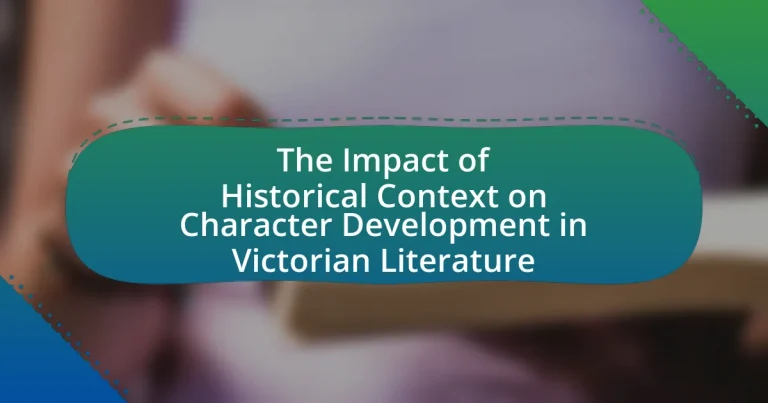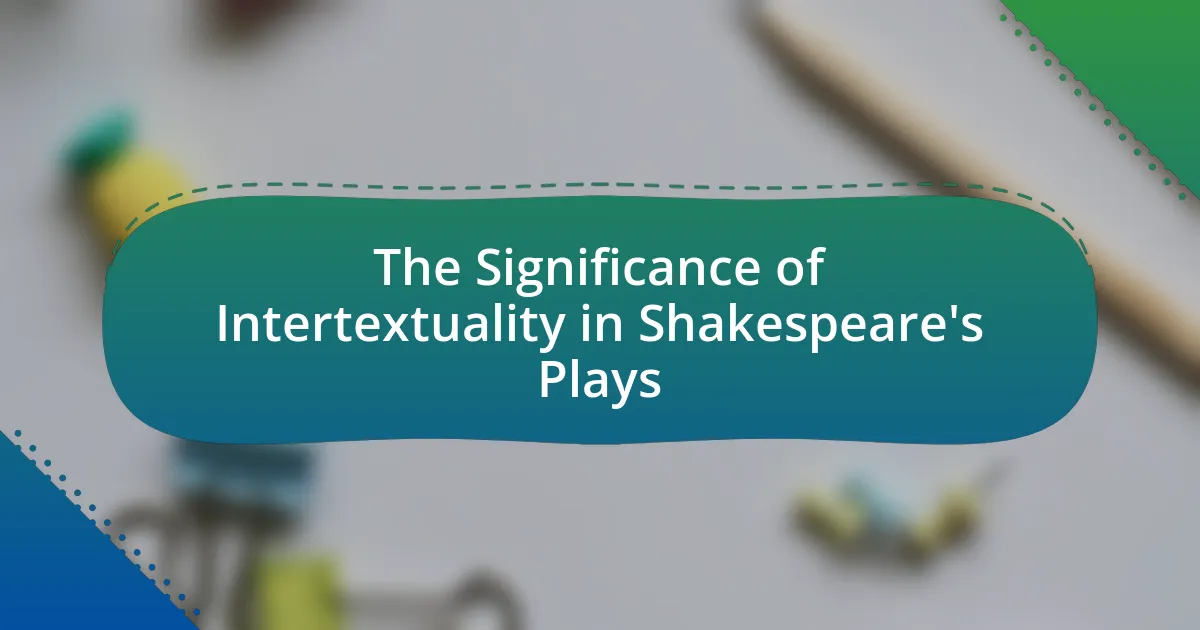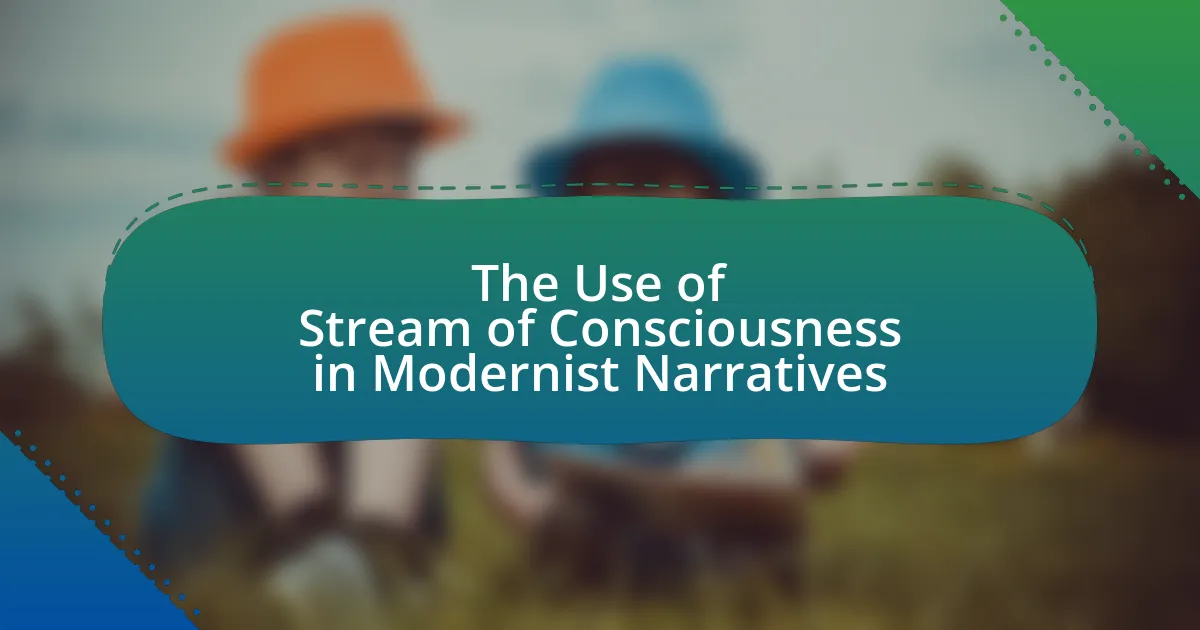The article examines the significant impact of historical context on character development in Victorian literature, highlighting how societal norms, values, and expectations shape characters’ motivations and conflicts. It discusses the influence of key historical events such as the Industrial Revolution, social reforms, and class distinctions on character traits and relationships, using examples from notable authors like Charles Dickens, George Eliot, and Thomas Hardy. The analysis reveals how these historical elements provide a framework for understanding the complexities of characters and their struggles within the rigid social structures of the Victorian era.
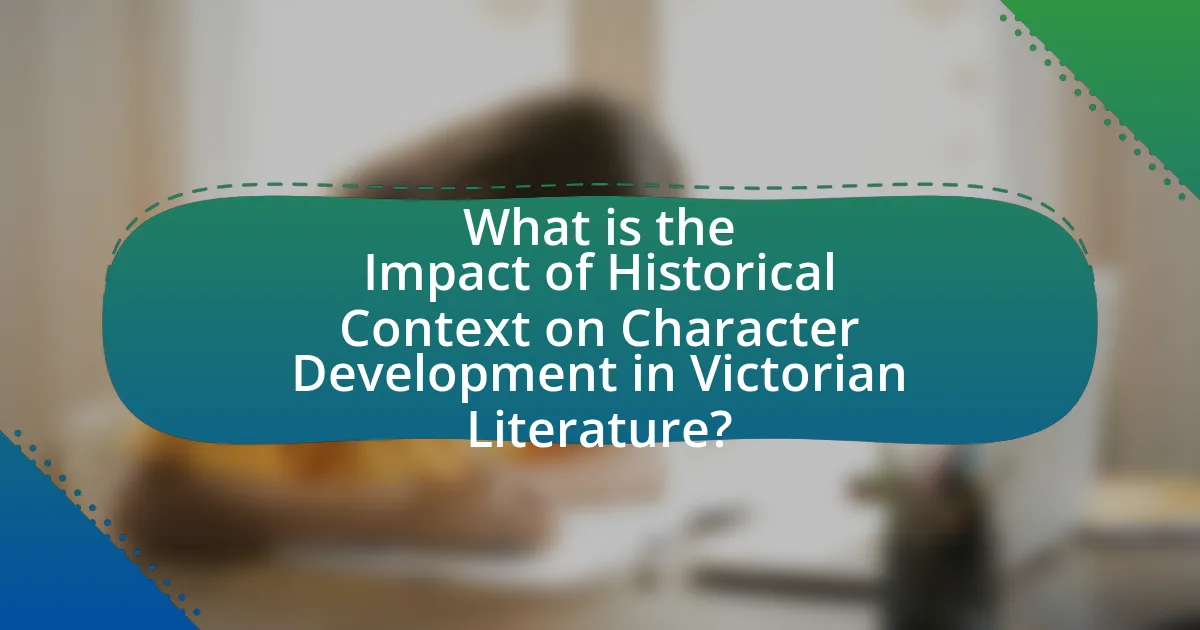
What is the Impact of Historical Context on Character Development in Victorian Literature?
Historical context significantly influences character development in Victorian literature by shaping societal norms, values, and expectations that characters must navigate. For instance, the rigid class structure and gender roles of the Victorian era often dictate characters’ motivations and conflicts, as seen in works like Charles Dickens’ “Great Expectations,” where Pip’s social aspirations drive his character arc. Additionally, the Industrial Revolution’s impact on society introduces themes of alienation and moral ambiguity, evident in Thomas Hardy’s “Tess of the d’Urbervilles,” where Tess’s struggles reflect the era’s changing social landscape. These historical elements provide a framework that informs character choices, relationships, and ultimately their fates, illustrating how deeply intertwined character development is with the historical context of the time.
How does historical context shape character traits in Victorian literature?
Historical context significantly shapes character traits in Victorian literature by reflecting the societal norms, values, and issues of the time. For instance, the rigid class structure and gender roles prevalent during the Victorian era influence characters’ behaviors and motivations, as seen in works like Charles Dickens’ “Great Expectations,” where Pip’s aspirations are deeply tied to his social status. Additionally, the Industrial Revolution’s impact on society is evident in characters’ struggles with moral dilemmas and personal identity, as illustrated in George Eliot’s “Middlemarch,” where characters navigate the complexities of social change and personal ambition. These contextual elements provide a framework that informs character development, making them representative of the historical realities of the Victorian period.
What specific historical events influenced character development during the Victorian era?
The specific historical events that influenced character development during the Victorian era include the Industrial Revolution, the expansion of the British Empire, and the social reforms of the time. The Industrial Revolution, which began in the late 18th century and continued into the 19th, transformed society by shifting populations from rural areas to urban centers, leading to new social classes and economic challenges that shaped characters in literature, such as the struggles of the working class depicted in Charles Dickens’ works. The expansion of the British Empire during this period introduced themes of colonialism and cultural encounters, influencing characters’ identities and moral dilemmas, as seen in Joseph Conrad’s “Heart of Darkness.” Additionally, social reforms, including the push for women’s rights and labor laws, prompted character development that reflected changing gender roles and class dynamics, evident in the writings of authors like George Eliot and Thomas Hardy. These events collectively provided a rich backdrop that informed the complexities and motivations of characters in Victorian literature.
How do social norms of the Victorian period affect character motivations?
Social norms of the Victorian period significantly influence character motivations by imposing strict expectations regarding morality, gender roles, and social class. These norms dictate behavior, compelling characters to conform to societal standards, which often leads to internal conflict and drives their actions. For instance, women were expected to embody virtues of purity and domesticity, as seen in characters like Elizabeth Bennet in “Pride and Prejudice,” whose motivations are shaped by the pressure to marry well and maintain social status. Similarly, male characters often grapple with the expectations of masculinity and success, as illustrated by the struggles of Pip in “Great Expectations,” who is motivated by the desire to rise above his humble beginnings and gain acceptance in higher social circles. Thus, the rigid social framework of the Victorian era serves as a catalyst for character development, shaping their desires, conflicts, and ultimately, their fates.
Why is understanding historical context crucial for analyzing Victorian characters?
Understanding historical context is crucial for analyzing Victorian characters because it provides insight into the societal norms, values, and challenges that shaped their behaviors and motivations. The Victorian era, characterized by strict social hierarchies, gender roles, and industrialization, influenced characters’ decisions and relationships. For instance, the expectations placed on women during this period, such as the ideal of the “Angel in the House,” directly impacted female characters like Esther Summerson in Charles Dickens’ “Bleak House.” This context allows readers to comprehend the complexities of characters’ struggles and the societal pressures they faced, making their actions more meaningful and relatable.
What role does historical context play in character relationships?
Historical context significantly influences character relationships by shaping societal norms, values, and expectations that characters navigate. In Victorian literature, for instance, the rigid class structures and gender roles dictated how characters interacted, often leading to conflicts or alliances based on social status. For example, in Charles Dickens’ “Great Expectations,” the relationship between Pip and Estella is heavily influenced by their differing social standings, reflecting the historical context of class disparity in 19th-century England. This context not only informs the characters’ motivations but also drives the plot, illustrating how historical circumstances can dictate personal connections and conflicts.
How does the Victorian setting enhance character complexity?
The Victorian setting enhances character complexity by providing a rigid social structure that influences individual behavior and moral dilemmas. This historical context, characterized by strict class divisions, gender roles, and societal expectations, forces characters to navigate conflicting desires and obligations. For instance, in Charles Dickens’ “Great Expectations,” the protagonist Pip grapples with his aspirations for social mobility while confronting the moral implications of his ambitions, illustrating how the Victorian era’s values shape personal identity and ethical choices. Such conflicts deepen character development, as individuals are often portrayed in a struggle between personal desires and societal pressures, revealing multifaceted personalities that reflect the complexities of their time.
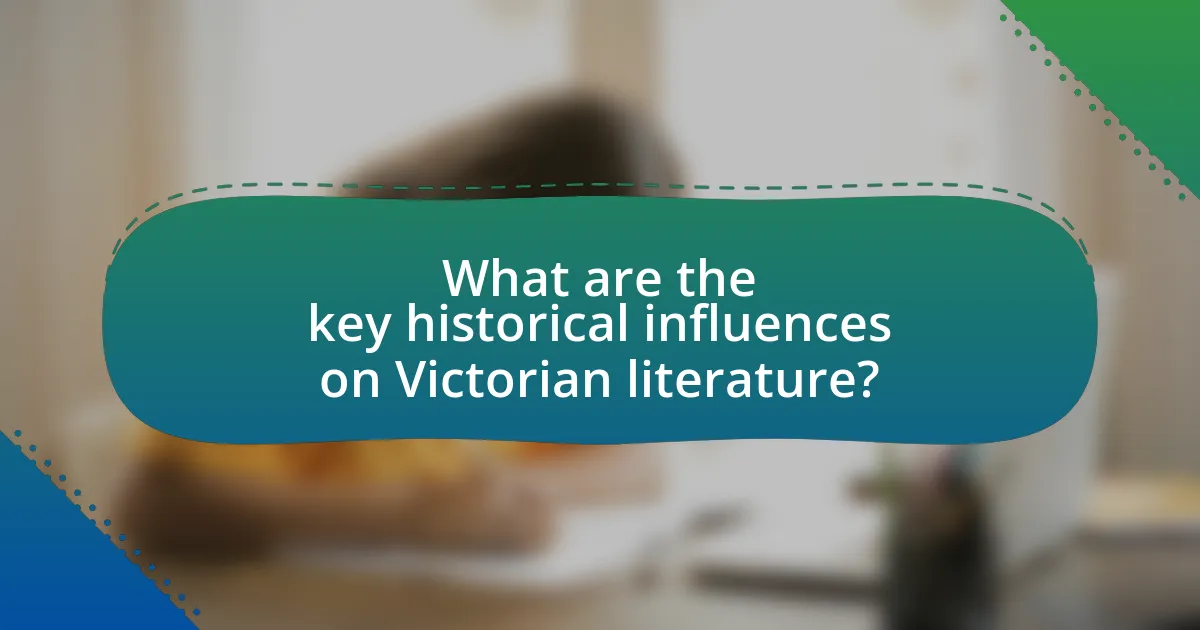
What are the key historical influences on Victorian literature?
Key historical influences on Victorian literature include the Industrial Revolution, social reform movements, and the expansion of the British Empire. The Industrial Revolution, which began in the late 18th century and continued into the 19th, transformed society by shifting populations from rural areas to urban centers, leading to new social classes and economic challenges that authors like Charles Dickens explored in their works. Social reform movements, such as the fight for women’s rights and labor rights, also shaped literature, as writers like George Eliot and Thomas Hardy addressed issues of gender and class in their narratives. Additionally, the expansion of the British Empire influenced themes of colonialism and cultural encounters, evident in the works of authors like Rudyard Kipling. These historical contexts provided a rich backdrop for character development and thematic exploration in Victorian literature.
How did the Industrial Revolution impact character development?
The Industrial Revolution significantly influenced character development in Victorian literature by introducing themes of social class, industrialization, and personal struggle. Characters often embodied the tensions between traditional values and the emerging industrial society, reflecting the moral dilemmas faced by individuals during this transformative period. For instance, in Charles Dickens’ “Hard Times,” the character of Stephen Blackpool represents the working class’s plight, illustrating the harsh realities of factory life and the struggle for personal integrity amidst economic exploitation. This portrayal highlights how the Industrial Revolution shaped individual identities and moral choices, emphasizing the conflict between personal aspirations and societal expectations.
What changes in society during the Industrial Revolution are reflected in character arcs?
Character arcs during the Industrial Revolution reflect significant societal changes, including shifts in class structure, urbanization, and the impact of industrialization on personal identity. Characters often transition from rural, agrarian lifestyles to urban settings, illustrating the migration of populations to cities for work in factories. This shift is evident in literature, where protagonists frequently grapple with the loss of traditional values and the emergence of new social hierarchies. For example, in Charles Dickens’ “Hard Times,” the character of Stephen Blackpool embodies the struggles of the working class, highlighting the harsh realities of industrial labor and the quest for social justice. Additionally, the rise of the middle class is depicted through characters who navigate the complexities of wealth and morality, as seen in George Eliot’s “Middlemarch,” where Dorothea Brooke’s aspirations reflect the changing roles of women and the pursuit of personal fulfillment amidst societal expectations. These character developments serve as a microcosm of the broader transformations occurring during the Industrial Revolution, illustrating how individuals adapt to and are shaped by their evolving environments.
How did class distinctions influence character portrayals in Victorian novels?
Class distinctions significantly influenced character portrayals in Victorian novels by shaping the social dynamics and moral values depicted in the narratives. Authors like Charles Dickens and George Eliot often illustrated the struggles and aspirations of characters from various social strata, highlighting the rigid class system of the time. For instance, in “Great Expectations,” Dickens portrays Pip’s transformation from a poor blacksmith’s apprentice to a gentleman, emphasizing the societal pressures and personal conflicts arising from class mobility. This reflects the Victorian belief that one’s social class dictated moral worth and personal identity. Additionally, characters such as Fagin and Miss Havisham serve as representations of the consequences of class disparity, illustrating how wealth and poverty can lead to moral corruption or isolation. Thus, the portrayal of characters in Victorian literature is deeply intertwined with the era’s class distinctions, revealing the complexities of social identity and ethical dilemmas.
What role did gender expectations play in character development?
Gender expectations significantly influenced character development in Victorian literature by dictating the roles and behaviors deemed acceptable for men and women. These societal norms often confined female characters to domestic spheres, emphasizing virtues like purity and submissiveness, while male characters were typically portrayed as assertive and dominant. For instance, in Charles Dickens’ “Great Expectations,” the character of Estella embodies the expectations placed on women to be beautiful yet emotionally detached, reflecting the limited agency afforded to women during the Victorian era. Conversely, male characters like Pip are allowed to pursue personal growth and ambition, illustrating the broader societal acceptance of male independence. This dichotomy in character development underscores how rigid gender roles shaped narratives and character arcs, reinforcing the historical context of the time.
How are female characters shaped by Victorian gender norms?
Female characters in Victorian literature are significantly shaped by the era’s gender norms, which emphasized domesticity, submission, and moral purity. These norms dictated that women were primarily responsible for the home and family, leading to characterizations that often portrayed them as passive, nurturing figures. For instance, characters like Elizabeth Bennet in “Pride and Prejudice” navigate societal expectations while also challenging them, reflecting the tension between individual desires and societal constraints. Additionally, the “Angel in the House” ideal, as articulated by Coventry Patmore, reinforced the notion that a woman’s primary role was to serve and support her husband and children, further influencing character development. This framework of gender expectations not only defined the roles women could occupy but also shaped their motivations, conflicts, and ultimate fates within the narratives.
What challenges did male characters face in the context of Victorian masculinity?
Male characters in the context of Victorian masculinity faced challenges related to societal expectations, emotional repression, and the pressure to conform to rigid gender roles. These characters were often expected to embody traits such as stoicism, strength, and moral integrity, which created internal conflicts when they experienced vulnerability or emotional struggles. For instance, literature from the period, such as Thomas Hardy’s “Jude the Obscure,” illustrates how male characters grapple with the limitations imposed by societal norms, leading to feelings of inadequacy and isolation. Additionally, the rise of industrialization and changing social dynamics further complicated their identities, as men were expected to be both providers and moral exemplars, often resulting in a sense of disillusionment and crisis of identity.

How do specific authors illustrate the impact of historical context on character development?
Specific authors illustrate the impact of historical context on character development by embedding societal norms, economic conditions, and cultural values into their narratives. For instance, Charles Dickens in “Great Expectations” portrays the class struggles of Victorian England through the character of Pip, whose aspirations and moral dilemmas reflect the rigid class system and the industrialization of society. Similarly, George Eliot in “Middlemarch” uses the character of Dorothea Brooke to explore the limitations placed on women in the 19th century, highlighting the tension between personal ambition and societal expectations. These authors effectively demonstrate how historical context shapes characters’ motivations, decisions, and ultimately their fates, providing readers with a deeper understanding of the societal influences at play during the Victorian era.
What techniques do authors like Charles Dickens use to reflect historical context in characters?
Authors like Charles Dickens use techniques such as detailed character backstories, social commentary, and vivid settings to reflect historical context in characters. Dickens often provides extensive backgrounds for his characters, illustrating their social status and personal struggles, which are deeply rooted in the socio-economic conditions of Victorian England. For example, in “Oliver Twist,” the character of Oliver represents the plight of orphaned children during the Industrial Revolution, highlighting issues of poverty and child labor. Additionally, Dickens employs social commentary to critique societal norms and injustices, as seen in “A Christmas Carol,” where Ebenezer Scrooge’s transformation reflects the changing attitudes towards wealth and generosity in a rapidly industrializing society. The settings in his works, such as the grimy streets of London, further contextualize the characters’ experiences, making the historical backdrop integral to their development and the narrative.
How does Dickens portray social issues through his characters?
Dickens portrays social issues through his characters by using them as representations of various societal classes and their struggles. For instance, in “Oliver Twist,” the character of Oliver embodies the plight of orphaned children in Victorian England, highlighting the harsh realities of poverty and the inadequacies of the workhouse system. Similarly, Ebenezer Scrooge in “A Christmas Carol” illustrates the consequences of greed and social indifference, serving as a critique of the capitalist attitudes prevalent during Dickens’ time. These characters are not merely fictional; they reflect the historical context of the 19th century, where issues such as child labor, class disparity, and social reform were pressing concerns. Dickens’ detailed characterizations and their experiences provide a lens through which readers can understand the broader social issues of his era.
What character traits are emphasized in the works of George Eliot in relation to historical context?
George Eliot emphasizes traits such as moral complexity, empathy, and intellectual depth in her characters, reflecting the historical context of Victorian society. These traits are significant as they challenge the rigid moral codes and social conventions of the time, illustrating the struggles individuals faced in navigating personal desires and societal expectations. For instance, in “Middlemarch,” characters like Dorothea Brooke embody the conflict between personal ambition and social duty, highlighting the evolving roles of women during the Victorian era. Eliot’s focus on the inner lives and moral dilemmas of her characters serves to critique the limitations imposed by a rapidly changing society, thereby reinforcing the importance of individual agency and ethical considerations in a historical context marked by industrialization and social reform.
How do the characters in Thomas Hardy’s works reflect the historical challenges of the Victorian era?
The characters in Thomas Hardy’s works embody the historical challenges of the Victorian era through their struggles with social class, gender roles, and moral dilemmas. For instance, in “Tess of the d’Urbervilles,” Tess’s plight illustrates the rigid class structures and the limited agency afforded to women, reflecting the societal expectations and constraints of the time. Additionally, Hardy’s character Jude Fawley in “Jude the Obscure” represents the conflict between personal aspirations and societal norms, highlighting the era’s tension between individual desires and institutional pressures. These characters’ experiences serve as a critique of Victorian values, showcasing the impact of industrialization, changing social dynamics, and the moral complexities faced by individuals in that historical context.
What themes in Hardy’s characters highlight the impact of societal changes?
Hardy’s characters often embody themes of social class struggle, gender roles, and the conflict between individual desires and societal expectations, highlighting the impact of societal changes during the Victorian era. For instance, in “Tess of the d’Urbervilles,” Tess represents the plight of women constrained by patriarchal norms and economic hardship, illustrating how societal expectations can dictate personal fate. Additionally, characters like Jude Fawley in “Jude the Obscure” confront the rigid class structures and educational barriers of the time, showcasing the tension between personal ambition and societal limitations. These themes reflect the broader historical context of the Victorian period, where rapid industrialization and shifting social dynamics profoundly influenced individual lives and relationships.
How does Hardy’s portrayal of fate and free will relate to historical context?
Hardy’s portrayal of fate and free will is intricately linked to the historical context of the Victorian era, particularly the tension between emerging scientific rationalism and traditional beliefs. During this period, the rise of Darwinian thought challenged the notion of divine intervention, leading to a worldview where characters often grapple with predetermined destinies shaped by social and environmental factors. For instance, in “Tess of the d’Urbervilles,” Tess’s tragic fate is influenced by her social class and the rigid moral codes of society, reflecting the historical constraints faced by individuals in Victorian England. This alignment of fate with societal forces illustrates how Hardy critiques the limitations of free will within the context of a rapidly changing world, where personal agency is often undermined by external circumstances.
What practical insights can be drawn from analyzing character development in Victorian literature?
Analyzing character development in Victorian literature reveals insights into societal norms, gender roles, and moral dilemmas of the era. For instance, characters often reflect the rigid class structures and expectations of Victorian society, as seen in works like “Pride and Prejudice” by Jane Austen, where Elizabeth Bennet’s character challenges social conventions. Additionally, the evolution of characters such as Pip in “Great Expectations” by Charles Dickens illustrates the impact of personal ambition and social mobility, highlighting the tension between individual desires and societal constraints. These character arcs provide a lens through which to understand the complexities of Victorian life, including the struggles for identity and agency within a restrictive social framework.
